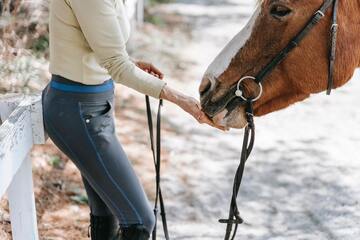 Recently, I had the pleasure of watching a DisruptHR presentation given by a friend about her best leadership experience. It got me thinking about my own most impactful leadership experience, and it's not what I ever expected it would be. It started when I inherited the regional talent management portfolio of the global company I was working for. A group of high potentials had been promised accelerated leadership development, and I was in charge of making it happen. But then, downsizing and budget cuts threatened to slash the program entirely. I knew that if I showed any doubt about the program's viability, it would be the end of it--leaving us with a group of high potentials who would quickly become flight risks. So I fought to keep the program alive, but I was nervous. I was nervous because Day 1 of the program made me skeptical. It involved taking the leaders off-site to work with horses. As layoffs were happening in the company, the optics of senior leaders spending the day playing with horses made me nauseous. Working with horses was meant to serve three purposes: (1) to get the leaders out of their element, force vulnerability and spark new learning; (2) to build a shared team experience, and; (3) to highlight the importance of nonverbal communication, as horses are highly sensitive animals. Given that this company was very hands-on and action-oriented, I figured this might have merit. The day arrived with various exercises involving the horses. There were more horses than people, so I was able to join in to 'audit' the program myself. The first lesson I witnessed was from a leader who could not connect with the horse. Despite his insistence and increasing assertive commands, the horse was not going to follow his lead. His non-verbal communication was indicating that he was not comfortable with horses, and so the horse refused to follow him. He had not allowed himself to be vulnerable upfront and build a connection with the horse. He realized that when they weren't getting results, their style was to become more assertive, and because that approach wasn't effective, they were creating a greater rift between the leader and the follower. In the same exercise, I had no problem quickly building a bond with my horse, and the trust between us was palpable. I didn't have to say a word or even use reins, and the horse would just follow me. A+ for me, right? Well, the bond became too friendly, and I overused my strength. The horse would now follow me when it was no longer required or nudge me to play or to gain direction. This was my lightbulb moment. Both in my professional and personal life, I've struggled dealing with people who seem to have a co-dependency. People depend on me for things when I knew they could do on their own. But this exercise helped me realize that this co-dependency was my own doing. To build relationships and trust quickly, I create the co-dependency. And while this helps me feel in control and competent, it does not help me get out of the weeds and let people experiment on their own. The final lesson we learned was about teamwork. A group of three worked together with a horse to complete an obstacle course. One person led the horse with reins, another gave instructions on how to navigate the course with a map, and the third rode the horse blindfolded. This exercise required massive amounts of trust and communication, not only among the team members but also with the horse. The leaders recognized how much communication is truly needed between the "visionary" leader, the "project manager," and the participant/employee blind to the change. Navigating the course was 3-4 times slower than anticipated and when groups progressed too fast the blindfolded participant would halt the whole thing. Us as leaders quickly realized the importance of each role and how essential change management and communication were to completing the task. These lessons have stuck with me, even seven years later. So, am I suggesting that you get your leaders playing with horses? No, not necessarily. But I am encouraging you to put yourself and your leaders in uncomfortable situations that will test the agility of their skills with different audiences and in different contexts. I also encourage you to reflect on your strengths and question whether they are hindering your progress elsewhere. Trust me--it's worth it. Photo by Barbara Olsen : https://www.pexels.com/photo/woman-feeding-horse-7883123/
0 Comments
Leave a Reply. |
Archives
November 2020
Categories
All
|
 RSS Feed
RSS Feed
